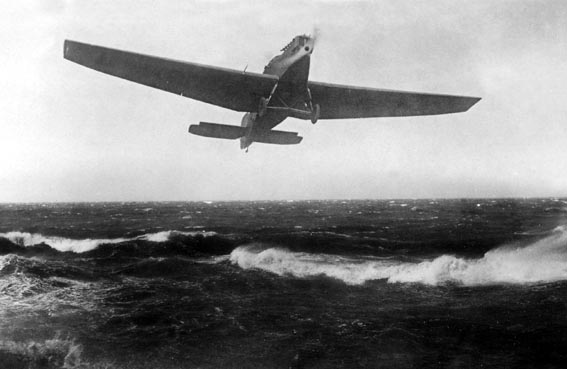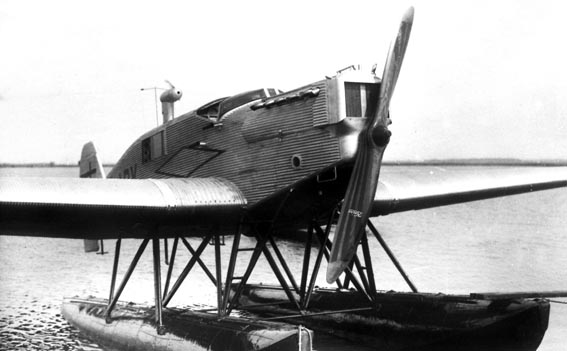|
Hazardous long-distance flights with the famous Junkers W 33
© Lennart Andersson, Günter Endres, Rob Mulder 2015 |
 |
The lure of flight was always stronger than the risk of failure, and the Atlantic continued to exert a magic pull. William Rody of Bad Ems had just come into a large inheritance, and he now had the financial wherewithal to follow his dream of flying across the Atlantic. In May 1931, he acquired Junkers W 33 D-2072 "Esa" (Espirito Santo Agostinho) (2516), which had originally been owned by American millionaire Charles Levine, who, together with his lover, Mabel Boll, known as "Queen of Diamonds" for her love of expensive jewellery, and the pilot Bert Acosta, wanted to fly from London to New York. This flight was never made and probably foundered on a lack of money.
Rody and pilot Friedrich Johannsen left Berlin-Tempelhof on 22 August 1931, planning to make an east-west crossing of the North Atlantic via Lisbon, where they arrived on 24 August. At 0930 hours on 10 September 1931, the trio, including a Portuguese viscount, Fernando da Costa Veiga, who paid GBP 440 for the passage and acted as co-pilot, took off from Lisbon headed for North America. A route via the Azores was chosen, in the hope of avoiding the storms and fog banks experienced on the more northerly route from Ireland. It was forlorn hope. Beyond the Azores, the crew experienced a heavy storm and took the aircraft up to 2,800m and navigated by the stars.
|
 |
A spark plug failed and this meant problems. The aircraft carried 2,450 litres of fuel, enough for 54 hours of flight, but with the remaining five cylinders working at full speed, more fuel was used than was anticipated. Johannsen sighted the steamship "Pennland", circled around it several times, but failed to attract attention to their plight. The tanks were completely empty as they neared Nova Scotia, and the crew was forced to ditch in the ocean at 2200 hours on 11 September. Although the W 33 had a wheeled undercarriage, and the ends of both wings broke up in the heavy squall, the empty tanks, which remained watertight, provided enough buoyancy to keep the aircraft afloat. Unfortunately, water entered the cabin and swept away all provisions, except one chocolate bar and nine litres of water, which was intended for the radiator. Junkers engineers had told Rody that the W 33 could keep afloat for 20 hours and when this limit was reached without a rescue in sight, the crew prepared themselves for the inevitable.
Veiga later wrote: "We expected to die any second, but we did not fear dying. I have a small revolver. When the time comes, I will shoot myself. And I will cut open my arteries, said Rody. I will drown with the aircraft; it doesn't matter how one dies. The captain was not enamoured with dying a hero. But the Junkers engineer was wrong. The little wonder aircraft did not sink." Gulls wheeling in the sky above suggested that they were not far from land, but no ship appeared on the horizon. The W 33 kept bobbing on the cold Atlantic waters for an incredible 158 hours, nearly seven days, before the crew, now starving and desperately short of water, was rescued by the Norwegian steamship "Belmoira". "I still waved my improvised flag, as the "Belmoira" put alongside our wreck and let down a rope ladder, which we could ascend," said Veiga, "up into the blissful found again life. "Unfortunately, the lifting gear on the ship was not suitable or adequate for raising the aircraft out of the water and, reluctantly, the crew had to abandon the W 33 to the elements.
Once the crew had left, water started to penetrate the aircraft, which tipped over and sank immediately.
|
 |
Westbound with Albin Ahrenberg's Junkers W 33 SE-ABX "Sverige"
The new engine arrived on 8 July and on 10 July Junkers W 33 "Sverige" finally left Iceland. This time, Greenland was reached without further incidents, but with 20 kilometres left to Ivigtut, the aircraft was suddenly and unexpectedly caught by a violent storm and Ahrenberg lost control. The aircraft quickly lost altitude but was thrown up again to almost 1,000 metres - only to sink violently again. When Ahrenberg regained control over the aircraft, they found themselves too far west, but when turning towards the coast, the offshore wind was so strong that the aircraft actually moved backwards. Diving was the only way to move forward! Ahrenberg finally managed to land on the water and drove the aircraft up on the shore, but in order to prevent the wind from blowing it back into the sea, he had to keep the engine running!
When the wind started to calm down the engine was shut down and the damage to the aircraft was assessed. The crew had suffered contusions and were bleeding from eyes, mouth and nose. One of the floats was damaged, the radio antenna wire was tangled twice around the rear fuselage and everything inside the cabin had been thrown around. Still, after some repairs, Ahrenberg and his crew took off from Greenland to continue the journey. One cannot but admire their persistence, perseverance and courage ...
However, there was no end to the hardships. This time, a cover plate on one of the wings came adrift and forced Ahrenberg to return to Ivigtut. During repairs, an extremely violent wind struck again. Both rudder and ailerons were severely damaged and the control wires were stretched and damaged. Some rudimentary repairs could be accomplished with local means, but the real problem was once again the engine. It was in bad shape and was estimated to work for just 8 or 10 hours more.
On 3 August, a desperate try was made to reach Labrador, just 900km away. With a strong tail wind a speed of almost 200 km/h was attained and everything looked bright at first, but fog and dark clouds met the aircraft, which soon found itself in the middle of a thunderstorm. The electric lights went out, instruments failed, the compass rotated wildly and the engine started to vibrate. On top of all this, the radio set began to burn, although the fire was quickly extinguished. When the aircraft came out of the clouds, Ahrenberg could establish that they were still east of the storm and he also saw that the whole coast was shrouded in fog. It was impossible to get through and make a safe landing
|
|
|
|





